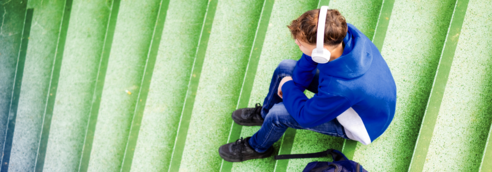The following activities will guide students in an exploration of the way negativity bias works, when it happens, and most important, how to recognize it in themselves. By developing this self‐awareness, students can become more open to different perspectives and engage in more thoughtful, civil discussions both in and out of the classroom.


Why do we often see the cup as half empty?
Objectives
-
Explain the bias.
-
Provide examples of the bias in practice.
-
Construct strategies for overcoming and dealing with the bias.
Materials Needed
-
Paper
-
Pencils/pens
-
Mental Notes graphic organizers for students
Bias Description
The negativity bias is a cognitive bias that causes people to pay more attention to negative information or experiences than to positive ones. This bias is why the pain of losing, or loss aversion, is psychologically more powerful than the pleasure of gaining.
Pros and Cons of the Bias
Pros
-
Negativity bias helped our ancestors survive by highlighting potential threats.
-
It can motivate us to take action to address negative situations and prevent future problems.
Cons
-
It can lead to a pessimistic outlook and an overemphasis on negative events, even when there is more positive evidence available.
-
Negativity bias can contribute to stress, anxiety, and negativity in our thoughts and behaviors.
Real‐World Examples of the Bias
-
During a school event, a student focuses more on a single embarrassing moment, like tripping on stage, than on the numerous positive interactions and feedback from friends and peers.
-
A student who earns 95 percent on a math test spends more time worrying about the missed 5 percent rather than feeling proud of the overall achievement.
Learning Activities
Open
- Have students write the name of the day’s bias and the driving question on their Mental Notes graphic organizer.
Activate
-
Use the prompts below to ask students to write down as many details as they can within 45 seconds about “A time when they …”
-
Discovered a new song/album/show/movie/book they loved.
-
Had a great conversation with someone or had a great experience with a friend/family member.
-
Were embarrassed.
-
Forgot something important or someone else forgot something important that affected them.
-
Ask
-
Did you notice any differences in your ability to remember the details of the positive versus negative statements/scenarios?
-
Why do you think you were able to recall more information about the negative items?
Explain
-
Describe the negativity bias and explain why it occurs. Tell students that our brains are wired to respond more intensely to negative events/surroundings/information than positive ones. Explain that 2 psychologists, Paul Rozin and Edward B. Royzman, wrote an article that suggests negativity bias occurs for the following reasons:
-
Negative events have a stronger “stickiness” in our minds. For example: We’re more likely to remember a time we were harshly criticized than a time we received positive feedback, even if both events had an equal impact.
-
Anticipating a negative event often causes our emotional responses to rise more quickly than the anticipation of a positive event. For example: The anticipation of a dreaded test causes increasing stress and anxiety as the test date nears, while anticipation of a fun field trip brings more excitement and less stress as the date approaches.
-
Negativity often dominates our impressions. For example: Even if a school trip has some positive moments, a single negative incident (like getting lost or being bullied) can overshadow the positive experiences and leave a negative overall impression.
-
Negative events require more cognitive effort to process, so they are often more memorable and intense. For example: We remember more vividly a time we failed a test than a time we aced it, because processing the failure required analyzing our mistakes, strategizing for improvement, and managing disappointment.
-
-
Tell students that they can effectively deal with negativity bias in the following ways:
-
Recognize and replace negative thoughts with more productive ones.
-
Use targeted self‐reflection questions that help counter negative thinking patterns.
-
Discuss
-
Divide students into groups and have them discuss the following questions:
-
In what situations can negativity bias be helpful? Harmful?
-
When have you seen this bias in action?
-
When are people most susceptible to this bias?
-
How can people recognize when they are being affected by this bias?
-
What are some ways to overcome and deal with this bias?
-
What is the relationship between this bias and humility? In what ways can our awareness of this bias improve our relationships with others?
-
Synthesize and Close
Ask each group to share what they discussed for at least 1 of the questions. Revisit the driving question and make sure each student has responded to the driving question in their Mental Notes for the day.